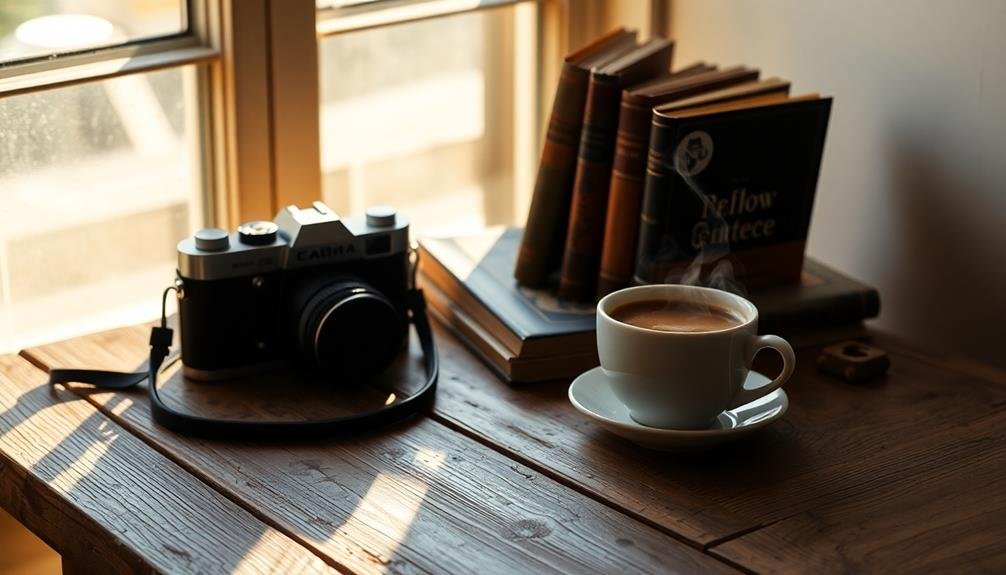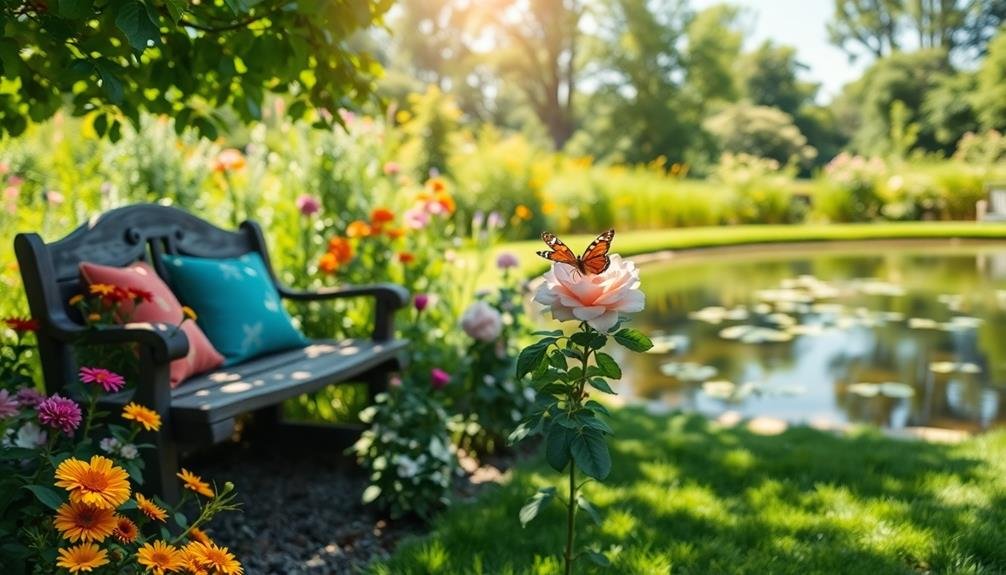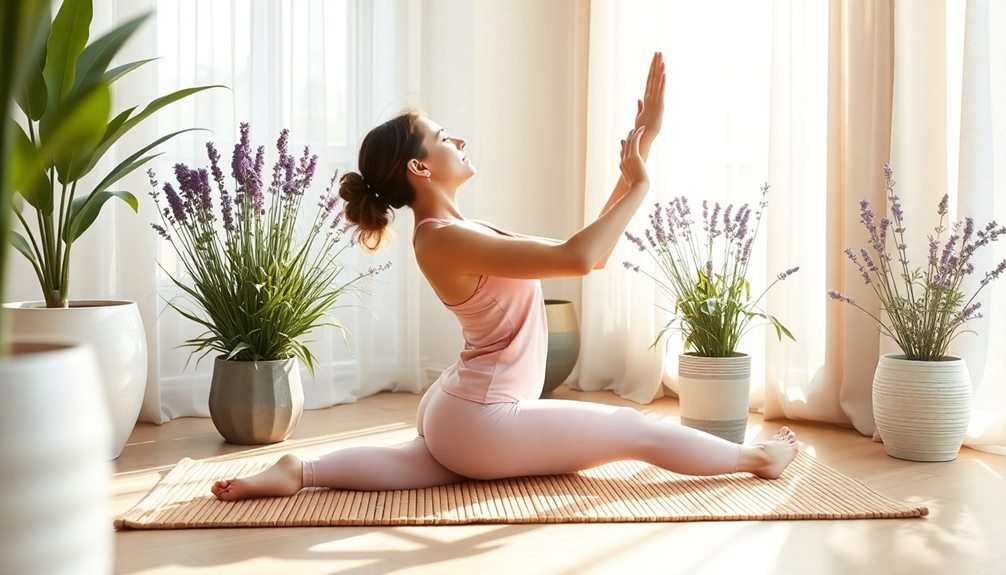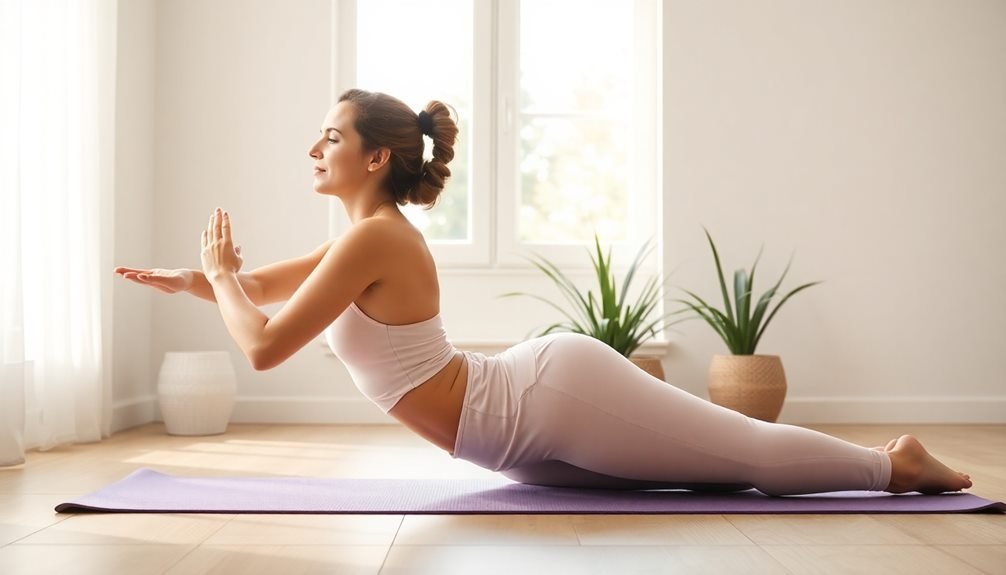Reveal the art of serene photography with these 10 beginner-friendly exercises. You'll discover beauty in everyday objects, master mindful framing techniques, and explore the interplay of light and shadow. Focus on textures and patterns to add depth to your images, and capture colorful moments of calm in nature and at home. Experiment with long exposures to create dreamy effects, and embrace negative space for striking compositions. Learn to tell visual stories without people and perfect the art of simplicity in your shots. With these exercises, you'll develop a keen eye for tranquil scenes and elevate your photography skills. The path to capturing serenity is just beginning.
Find Beauty in Everyday Objects

One of photography's greatest challenges is discovering beauty in the mundane. As a beginner, you'll need to train your eye to see the extraordinary in ordinary objects. Start by looking at familiar items around your home with fresh eyes. That worn coffee mug, a stack of books, or even a fruit bowl can become compelling subjects when viewed from new angles or in different lighting conditions.
Try focusing on textures, patterns, and shapes. Get up close to capture intricate details you might usually overlook. Experiment with composition techniques like the rule of thirds or leading lines to create visually interesting images. Play with light and shadow to add depth and drama to everyday objects.
Don't limit yourself to indoor subjects. Take a walk outside and observe the world around you. A weathered fence, a colorful leaf, or raindrops on a window can all make fascinating photographic subjects.
Practice Mindful Framing Techniques
Building on your newfound ability to see beauty in everyday objects, it's time to refine how you capture those subjects in your frame. Mindful framing techniques are essential for creating compelling compositions that draw viewers into your photographs. By carefully considering what to include and exclude from your shot, you'll create more impactful images.
To practice mindful framing, try these exercises:
- Use the rule of thirds: Divide your frame into a 3×3 grid and place key elements along the lines or at their intersections.
- Experiment with negative space: Leave intentional blank areas around your subject to create a sense of balance and emphasize your focal point.
- Frame within a frame: Use natural elements like doorways, windows, or arches to create a frame within your photograph, adding depth and context.
As you work on these techniques, pay attention to how different framing choices affect the mood and story of your images.
Don't be afraid to move around, change angles, or adjust your zoom to find the most effective composition. Remember, mindful framing isn't about following rigid rules but about making intentional choices that enhance your photographic vision.
Explore Light and Shadow Play

As you explore deeper into photography, understanding light and shadow becomes essential for creating enchanting images. Start by observing how light interacts with different objects throughout the day. Notice how the intensity and direction of light change, creating varying shadows and highlights.
Try this exercise: Choose a simple object and photograph it at different times of day. You'll see how the changing light affects its appearance and mood. Experiment with backlighting, side lighting, and front lighting to see how each alters the subject's form and texture.
Next, play with artificial light sources. Use a lamp or flashlight to create dramatic shadows. Move the light around your subject, noting how the shadows shift and transform. Don't be afraid to mix natural and artificial light for unique effects.
For a challenge, attempt low-key photography. This technique emphasizes shadows and dark tones, creating a moody atmosphere. Conversely, try high-key photography, which focuses on bright, airy images with minimal shadows.
Focus on Textures and Patterns
Turn your lens to the intricate world of textures and patterns surrounding you.
In nature, you'll find a wealth of detailed subjects, from the veins of leaves to the rough bark of trees.
For an urban twist, head to the city and capture the geometric patterns of architecture, the weathered surfaces of old buildings, or the repetitive elements in modern structures.
Nature's Intricate Details
Nature offers an endless array of textures and patterns for photographers to explore. From the intricate veins of a leaf to the rough bark of a tree, you'll find countless subjects to capture. This exercise challenges you to look closely at the world around you and appreciate the small details that often go unnoticed.
To practice photographing nature's intricate details:
- Use a macro lens or your camera's macro mode to get up close and personal with your subject.
- Experiment with different angles and lighting to highlight textures and patterns.
- Focus on contrasting elements, such as smooth pebbles against rough sand or delicate flower petals against spiky leaves.
As you search for compelling subjects, pay attention to the way light interacts with various surfaces. Shadows can enhance textures, while backlighting can reveal hidden patterns.
Don't forget to adjust your camera settings to guarantee sharp focus and proper exposure. You might need to increase your ISO or use a tripod for stability when shooting in low light conditions.
Urban Texture Hunt
The urban landscape is a treasure trove of textures and patterns waiting to be discovered through your camera lens. For this exercise, you'll explore your city or town, focusing on capturing interesting surfaces and repetitive designs. As you walk around, pay attention to both natural and man-made textures.
Look for:
| Natural Textures | Man-made Textures |
|---|---|
| Tree bark | Brick walls |
| Leaves | Metal gratings |
| Rock formations | Tiled floors |
| Water ripples | Graffiti |
Challenge yourself to find unique combinations of textures and patterns. Try shooting from different angles and distances to emphasize the details. Experiment with various lighting conditions to see how they affect the appearance of textures.
Don't forget to adjust your camera settings. Use a smaller aperture (higher f-number) for sharper details and greater depth of field. If you're shooting in low light, increase your ISO or use a tripod to avoid camera shake.
Capture Colorful Moments of Calm

Explore the serene side of color photography by seeking out tranquil scenes in nature and at home.
You'll find vibrant yet peaceful moments in blooming gardens, sunset-lit landscapes, or even in cozy corners of your living space.
Look for soothing color palettes and harmonious compositions that evoke a sense of calm, allowing you to capture both visual beauty and emotional resonance in your images.
Vibrant Tranquility in Nature
Amidst the bustling world around us, vibrant tranquility in nature offers photographers a unique opportunity to capture colorful moments of calm.
You'll find that these serene scenes not only provide stunning visuals but also help you practice various photography techniques. To capture vibrant tranquility in nature, focus on finding locations that blend vivid colors with peaceful atmospheres.
Consider these three exercises to enhance your nature photography skills:
- Sunrise reflections: Wake up early and head to a nearby lake or pond. Capture the brilliant colors of the rising sun as they reflect off the still water's surface.
- Wildflower meadows: Visit a local wildflower field during golden hour. Practice using a shallow depth of field to highlight individual flowers while creating a soft, colorful background.
- Autumn leaves: During fall, seek out colorful foliage in parks or forests. Experiment with different compositions, such as framing a peaceful stream with vibrant leaves or capturing the contrast between colorful leaves and a clear blue sky.
Remember to use a tripod for sharp images and experiment with different shutter speeds to capture movement in water or leaves.
Soothing Hues at Home
While nature offers stunning opportunities for capturing vibrant tranquility, you don't need to venture far to find soothing hues and moments of calm. Your home is a treasure trove of serene scenes waiting to be captured. Look for soft, muted colors in your living spaces that evoke a sense of peace.
Start by exploring different rooms during various times of the day. Morning light filtering through sheer curtains can create a dreamy atmosphere, while the warm glow of a lamp in the evening adds coziness to your shots.
Focus on textures that complement soothing hues, such as a fluffy blanket draped over a chair or the smooth surface of a ceramic vase.
Don't overlook everyday objects that can become subjects of tranquil compositions. A steaming cup of tea, a stack of well-worn books, or a vase of fresh flowers can all convey a sense of calm.
Experiment with different angles and perspectives to find the most appealing arrangement. Pay attention to negative space, allowing areas of simplicity to balance your composition and enhance the overall feeling of serenity in your photographs.
Document Your Gratitude Journey
A powerful way to enhance your photography skills while cultivating a positive mindset is to document your gratitude journey through images. This exercise challenges you to capture moments, objects, or people that inspire thankfulness in your daily life.
As you train your eye to seek out these positive elements, you'll develop a keener sense of composition and lighting while fostering a more appreciative outlook.
To get started with your gratitude photography project:
- Set a daily or weekly goal to photograph one thing you're grateful for
- Experiment with different perspectives and angles to highlight the subject's significance
- Create a digital or physical album to showcase your gratitude images over time
As you practice this exercise, you'll find yourself becoming more attuned to the beauty in everyday moments. You might capture the warm glow of sunlight streaming through your window, the comforting smile of a loved one, or the intricate details of a favorite object.
Slow Down With Long Exposures

Slowing down your shutter speed opens up a world of creative possibilities in photography. Long exposures allow you to capture motion blur, light trails, and smooth out water or clouds. To get started, you'll need a tripod and a camera with manual settings. Choose a low ISO (100-200) and a small aperture (f/8-f/16) to maintain image quality and depth of field.
Experiment with different shutter speeds to achieve various effects:
| Subject | Shutter Speed | Effect |
|---|---|---|
| Water | 1/2 – 2 sec | Silky smooth |
| Traffic | 10 – 30 sec | Light trails |
| Stars | 15 – 30 sec | Star trails |
Start with easier subjects like flowing water or city lights at night. As you gain confidence, try more challenging scenes like star trails or light painting. Remember to use a remote shutter release or your camera's self-timer to avoid camera shake. Don't be afraid to play with different compositions and perspectives. Long exposure photography requires patience, but the results can be truly breathtaking. With practice, you'll learn to see the world in a new, slower-paced light.
Embrace Negative Space
Negative space can be a powerful tool in your photography toolkit.
By emphasizing your subject through the absence of surrounding elements, you'll create striking, minimalist compositions.
Experiment with leaving large areas of your frame empty, drawing the viewer's attention to your main subject and creating a sense of simplicity and balance in your images.
Emphasize Subject Through Absence
While many photographers focus on filling the frame, embracing negative space can create powerful, striking images. This technique involves intentionally leaving large areas of the composition empty or minimally filled. By doing so, you'll draw attention to your subject and evoke a sense of tranquility or isolation.
To emphasize your subject through absence, consider the following:
- Use a simple background: Choose a plain wall, clear sky, or calm water to create a clean, uncluttered space around your subject.
- Position your subject off-center: Place your main focus to one side of the frame, leaving the rest empty to create visual interest and balance.
- Experiment with scale: Juxtapose a small subject against a vast empty space to convey a sense of isolation or insignificance.
When practicing this technique, look for opportunities in various settings. Urban environments offer stark architectural lines and open spaces, while natural landscapes provide expansive skies or bodies of water.
Create Minimalist Compositions
Simplicity in photography can yield powerful results. To create minimalist compositions, you'll need to embrace negative space and focus on a single, strong subject.
Start by identifying a scene with a clear, isolated element surrounded by ample empty space. This could be a lone tree in a snow-covered field or a solitary figure on a vast beach.
When composing your shot, position your subject off-center using the rule of thirds. This will create visual interest while maintaining a sense of balance.
Pay attention to the empty space around your subject, ensuring it's clean and free from distractions. Use a wide aperture to blur the background and further isolate your subject.
Experiment with different angles and perspectives to find the most compelling composition. Sometimes, getting low to the ground or shooting from above can dramatically change the impact of your image.
Don't be afraid to crop tightly in post-processing to enhance the minimalist feel.
Create Visual Stories Without People

Storytelling through photography doesn't always require human subjects. You can create compelling visual narratives using landscapes, objects, and natural elements. This exercise challenges you to convey emotions, tell a story, or capture a moment in time without relying on people in your frame.
Start by selecting a theme or concept you'd like to explore. It could be anything from "passage of time" to "urban decay" or "the cycle of seasons." Once you've chosen your subject, look for scenes and compositions that embody your chosen narrative. Pay attention to lighting, colors, and textures that can enhance the mood of your story.
Here are three ways to create visual stories without people:
- Use symbolism: Incorporate objects or elements that represent broader concepts or emotions.
- Capture sequences: Take a series of photos that show progression or change over time.
- Focus on details: Zoom in on specific features that tell a larger story.
Master the Art of Simplicity
In today's visually cluttered world, mastering simplicity in photography can make your images stand out. To achieve this, focus on minimalism and negative space.
Start by selecting a single subject and removing any distracting elements from your frame. Look for clean backgrounds or use a shallow depth of field to blur out unnecessary details.
Experiment with composition techniques like the rule of thirds or centering your subject. Pay attention to lines, shapes, and patterns that can guide the viewer's eye.
Try using a monochromatic color scheme or limiting your palette to create a more cohesive and simple image.
When shooting, move around your subject to find the most compelling angle that emphasizes its form and reduces complexity. Don't be afraid to crop tightly or leave ample empty space around your subject.
Practice simplifying complex scenes by identifying the essential elements and eliminating the rest. Look for opportunities to use silhouettes or high contrast to reduce detail and create bold, simple shapes.
Frequently Asked Questions
What Camera Equipment Is Essential for Beginners Practicing Serenity Photography?
You don't need fancy gear for serenity photography. Start with a basic camera or smartphone, a sturdy tripod, and a wide-angle lens. Consider a neutral density filter for long exposures. Remember, it's your eye that captures serenity.
How Can I Overcome Creative Blocks When Trying to Capture Serene Moments?
To overcome creative blocks when capturing serene moments, try changing your perspective. Explore new locations, experiment with different times of day, and challenge yourself to find beauty in unexpected places. Don't be afraid to break photography rules.
Are There Specific Post-Processing Techniques to Enhance the Serenity in Photos?
To enhance serenity in your photos, you can use post-processing techniques like softening colors, increasing contrast subtly, and applying a gentle vignette. You'll also want to reduce noise, adjust white balance, and experiment with selective blurring for a calming effect.
What Are the Best Times of Day for Capturing Serene Scenes?
You'll find the most serene scenes during the golden hours: just after sunrise and before sunset. Early mornings offer tranquil mist and soft light, while evenings provide warm hues and long shadows. Avoid harsh midday light for peaceful shots.
How Can I Incorporate Mindfulness Practices Into My Photography Routine?
You can incorporate mindfulness into your photography by practicing deep breathing before shoots, focusing on the present moment, observing your surroundings with all senses, and taking time to appreciate each scene before capturing it. It'll enhance your creativity and calm.
In Summary
You've now got a toolkit of simple exercises to elevate your photography skills and capture serenity in your images. Remember, it's not about having the fanciest gear; it's about training your eye to see beauty in the everyday. Keep practicing these techniques, and you'll soon find yourself creating stunning, peaceful compositions effortlessly. Don't be afraid to experiment and develop your unique style. Most importantly, enjoy the process of capturing tranquility through your lens.





Leave a Reply